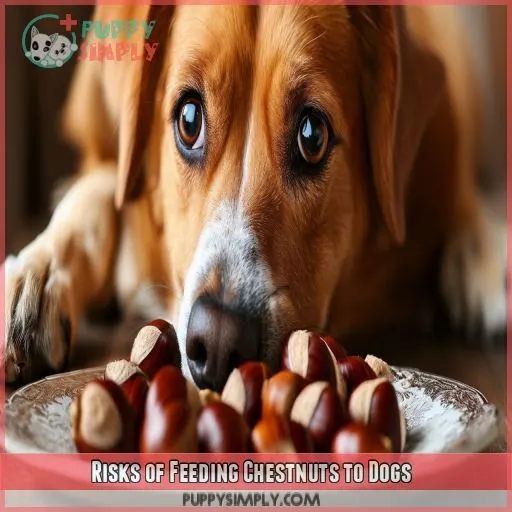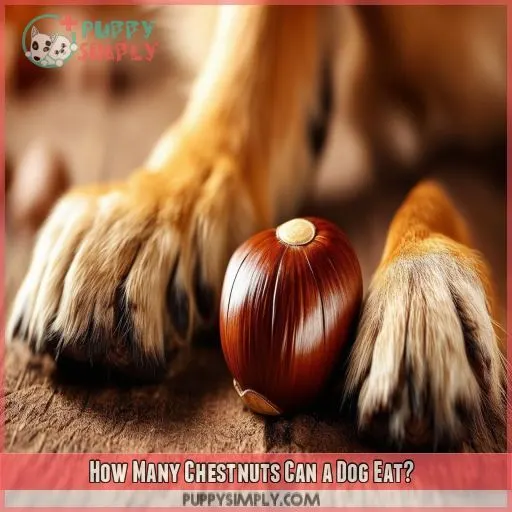This site is supported by our readers. We may earn a commission, at no cost to you, if you purchase through links.
 You’re probably aware that dogs will eat just about anything.
You’re probably aware that dogs will eat just about anything.
But when it comes to chestnuts, can they join in on the seasonal fun?
The short answer is yes, dogs can eat chestnuts.
However, before you offer your furry friend this tasty treat, there are a few things you should know.
Table Of Contents
Key Takeaways
- Chestnuts are a safe and healthy treat for dogs, offering vitamins and nutrients that support their overall health.
- It’s important to avoid horse chestnuts, as they can make your dog ill. Stick to American chestnuts or other safe alternatives.
- Choking and intestinal blockages are risks, so chop or crush chestnuts and always remove shells before feeding them to your pup.
- Allergic reactions are rare but possible, so keep an eye out for any unusual symptoms and consult your vet if concerned.
Can a Dog Eat Chestnuts?
I’m here to help, but it seems like you intended to provide a paragraph of text for me to organize. If you could please provide the paragraph, I would be happy to help you reorganize it as per your instructions.
Can Dogs Eat Chestnuts?
You might be wondering if it’s safe to share those roasted chestnuts with your furry friend during the holidays. The short answer is yes, dogs can eat chestnuts, but there are a few important risks to keep in mind before offering them this tasty treat.
What Makes Chestnuts Safe for Dogs
So, can dogs eat chestnuts? Yes, they can—but only the right kind. Most chestnuts are non-toxic to dogs and can be consumed safely in moderation. The most common type is the American chestnut, which is safe for canines to eat in small amounts.
But here’s the catch: avoid horse chestnuts. They’re not true chestnuts and can make your dog very ill.
Nutritional Value of Chestnuts for Dogs
So, can dogs eat chestnuts?
Yes, they can, and they’re a healthy treat, too.
Chestnuts are rich in vitamin C, which is rare in nuts.
They also contain B vitamins, copper, manganese, vitamin B6, and folate.
Plus, they’re a good source of fiber and antioxidants.
All these nutrients support your dog’s overall health, from immune function to brain power and digestive health.
Risks of Feeding Chestnuts to Dogs
While chestnuts can be a tasty and nutritious treat for your dog, it’s important to be aware of potential risks. From choking hazards to intestinal blockages and even allergic reactions, there are a few things to keep in mind before offering your dog this seasonal snack.
Choking Hazards of Whole Chestnuts
Yes, chestnuts can pose a choking hazard to dogs, especially when given whole. Here’s why:
- Chestnut Size: Their size can be a choking risk, especially for smaller dog breeds.
- Cooked vs. Raw: Cooked chestnuts are softer and less likely to cause choking, but Raw chestnuts are harder and could potentially block your dog’s airway.
- Dog Breed: Smaller dog breeds with tinier mouths and throats are more susceptible to choking on whole chestnuts.
To reduce the risk of choking:
- Chop or crush the chestnuts into smaller pieces before feeding them to your dog.
- Watch your dog while they’re eating chestnuts to make sure they don’t choke.
Intestinal Blockages From Chestnut Shells
Whole chestnuts pose a choking hazard.
Their shells can also cause intestinal blockages in dogs. Chestnut shells are tough and fibrous, and if swallowed, they can get lodged in your dog’s intestines.
This can lead to painful blockages that require veterinary attention.
To avoid this risk, always remove the shells before feeding chestnuts to your dog. Opt for peeled or boiled chestnuts, and watch your dog to make sure they don’t gobble down the shells.
Allergic Reactions to Chestnuts in Dogs
Chestnut allergies in dogs are rare, but it’s important to be aware of the signs.
Allergic reactions in dogs can manifest as skin rashes, digestive issues, and respiratory problems.
More severe symptoms, like a sudden drop in blood pressure or loss of consciousness, require immediate veterinary attention.
Always consult your vet if you suspect an allergic reaction in your dog after consuming chestnuts.
How Many Chestnuts Can a Dog Eat?
So, how many chestnuts are safe for your pup to munch on? Well, that depends on their size. Smaller dogs will have a lower tolerance than their larger counterparts.
Let’s get into the specifics and find out the safe amounts of chestnuts for small and large dog breeds, as well as other factors that can affect your dog’s chestnut consumption.
Safe Amounts of Chestnuts for Small Breeds
For small breeds, it’s best to be extra cautious with chestnut dosage. A good rule of thumb is to offer no more than one or two chestnuts at a time, and even then, make sure they’re properly prepared by removing the shell and roasting or boiling them first. This reduces the risk of choking and makes them easier to digest.
Safe Amounts of Chestnuts for Large Breeds
For large dog breeds, you can offer them a few more chestnuts as a treat. As a rule of thumb, aim for no more than 3-4 chestnuts per day for a large dog. This amount helps them get a tasty treat without overdoing it. Remember, chestnuts are still a high-calorie snack, so moderation is key to keeping your pup healthy.
Factors Affecting Chestnut Tolerance in Dogs
Figuring out how many chestnuts your dog can safely eat depends on a few things, like their breed, size, age, and how healthy they are.
For example, smaller breeds like Chihuahuas or toy poodles might only be able to handle a few chestnuts at a time, while larger breeds like Labradors or German Shepherds could handle a slightly larger amount.
Age and health also matter. Puppies and senior dogs might’ve more sensitive stomachs, so you’d want to start with smaller portions and gradually increase them if no issues arise. If your dog has any health conditions, always check with your vet first.
Healthy Alternatives to Chestnuts for Dogs
While chestnuts can be a tasty treat for your dog, you might be wondering about other options that offer similar benefits without the risks. In this section, we’ll explore nutritious alternatives that will delight your dog’s taste buds and provide a healthy boost.
From similar store-bought treats to homemade goodies, we’ll guide you through safe and delicious options that will have your furry friend begging for more.
Nutritious Treats Similar to Chestnuts
If you’re looking for healthy alternatives to chestnuts for your dog, there are plenty of options. Here are three nutritious treats similar to chestnuts that your dog will love:
- Apples: packed with fiber, vitamin C, and antioxidants. Just remember to remove the seeds and core first.
- Carrots: low in calories, high in fiber, and a great source of vitamin A for your dog’s eye health.
- Water chestnuts: these aquatic root vegetables are safe for dogs and can be shared straight from the can.
Homemade Dog Treats With Chestnut Substitutes
If you’re looking for homemade dog treats with a chestnut-like flavor, there are several substitutes you can use.
- Hazelnuts have a similar texture and taste to chestnuts.
- Pecans are a close relative of chestnuts and work well as a replacement.
- Macadamia nuts add an extra nutty flavor, but use sparingly due to their strong taste.
- Jackfruit seeds are a safe alternative for those with nut allergies and have a similar taste and texture to chestnuts.
- Pistachios can also be used as a substitute, but in a 1:1 ratio with chestnuts.
Frequently Asked Questions (FAQs)
Are chestnuts toxic to dogs?
No, chestnuts aren’t toxic to dogs, but large amounts can cause gastrointestinal distress and even pancreatitis. So, only feed your dog small amounts of chestnuts and watch for any reactions.
How many chestnuts can a small dog eat?
A couple of chestnuts a week is a good rule of thumb, but watch for signs of digestive issues. Toy breeds may only need half a chestnut.
What are the health benefits of chestnuts for dogs?
Chestnuts are chock-full of vitamins and nutrients that are good for your dog’s health. They’re high in fiber, omega-3 fatty acids, and protein, and can even help prevent heart disease and unhealthy weight gain. Just remember, moderation is key, and always check with your vet first.
Can dogs eat raw chestnuts?
Raw chestnuts are fine for dogs to eat, but you should chop them up to prevent choking. They’re a good source of vitamins and nutrients, but their shells are tough to remove.
What are the symptoms of pancreatitis in dogs?
Did you know that the enzymes in a dog’s body can start digesting the pancreas, causing extreme pain? Pancreatitis symptoms include abdominal pain, vomiting, nausea, dehydration, and loss of appetite.
Conclusion
So, can dogs eat chestnuts? Yes, they can, but it’s not without risks.
While chestnuts offer nutritional benefits, they also pose potential dangers like choking, intestinal blockages, and allergic reactions.
To keep your dog safe, supervise them when eating chestnuts, make sure the shells are removed, and be mindful of portion sizes.
If you’re unsure, consult your vet, especially if your dog has a sensitive stomach or known allergies.
With the right precautions, your furry friend can safely join in on the seasonal fun of enjoying chestnuts.










